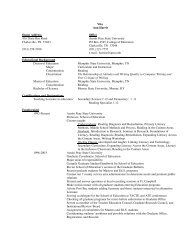Titration of an acid with a base lab
Titration of an acid with a base lab
Titration of an acid with a base lab
You also want an ePaper? Increase the reach of your titles
YUMPU automatically turns print PDFs into web optimized ePapers that Google loves.
5. Pull 25 mL <strong>of</strong> the <strong>acid</strong> solution into the volumetric pipette <strong>an</strong>d tr<strong>an</strong>sfer into <strong>an</strong> Erlenmeyer flask.<br />
Add 2-3 drops <strong>of</strong> phenolphthalein to the <strong>acid</strong> solution in the Erlenmeyer flask.<br />
6. Place the flask under the buret <strong>an</strong>d start adding the <strong>base</strong> solution to the Erlenmeyer flask. Have<br />
one <strong>lab</strong> partner swirl the flask while the other controls the stopcock. When pink starts to<br />
develop, add the solution more slowly. At this point you should add one drop at a time followed<br />
by swirling until a very light pink color persists. Remember, the lighter the pink the better!!!<br />
7. Record the final reading <strong>of</strong> the buret. Wash the contents <strong>of</strong> the flask down the drain <strong>with</strong> water.<br />
8. Refill the buret <strong>with</strong> more sodium hydroxide solution. Record the new volume under trial 2 on<br />
the data sheet. Get <strong>an</strong>other sample <strong>of</strong> <strong>acid</strong> <strong>an</strong>d add the phenolphthalein as before <strong>an</strong>d repeat<br />
the titration 2 more times.<br />
9. Fill in the data sheet <strong>an</strong>d post-<strong>lab</strong> questions. Show your work for full credit!!!
















